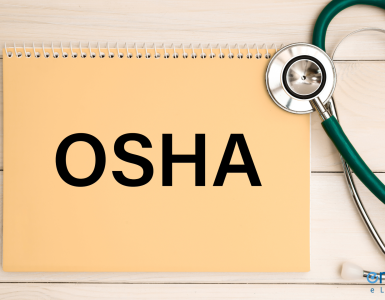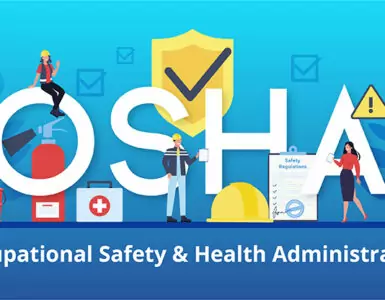 It is always found that physicians, physician assistants, nurse, nurse practitioners and other health professionals frequently encounter work related safety and health question while they are on their job. The present article will enlighten the readers with adequate information and resources and help the clinicians with adequate knowledge about OSHA (Occupational Safety and Health Administration).
It is always found that physicians, physician assistants, nurse, nurse practitioners and other health professionals frequently encounter work related safety and health question while they are on their job. The present article will enlighten the readers with adequate information and resources and help the clinicians with adequate knowledge about OSHA (Occupational Safety and Health Administration).
The article discusses about all types of ethical, clinical and regulatory issues. All most all the relevant issues such as specific occupation, hazardous exposure, occupational health topics and specific industries have been discussed about.
Mission mode of OSHA
The mission of OSHA is to ensure safe and healthy working conditions for both women and men by the development, settlement and enforcement of standards, in addition to providing training, education plus outreach and compliance assistance. The law ensures safe workplace for the employers.
Present condition
OSHA is up on its toes to spread site-specific information. In its SST (Site-Specific Targeting) -12 releases it has emphasized on inspection plan, that specifies establishing OSHA in the SS-inspection. The target list here bases DART (Days Away, Restricted or Transferred) rates and DAFWII (Days Away from work injury and illness) rates. OSHA maintains a record of high-rated employers for undertaking inspection.
SST-12 related information
The enlisted SST-12 does not mention about construction sites; the other lacuna of the list is it focuses only those establishments that employ 20 or more employees. SST-12 also includes NEIP (National Emphasis Inspection Programs) that target some specific types of injuries (nursing, amputations, combustible dust and residential care facilities or high-risk industries)
SST related information is available from OSHA record keeping data companies, these companies are supposed to maintain these data. OSHA Data Initiative or (ODI) handles these data collection responsibility. OSHA is targeting the manufacturing facilities through DART rate minimum or above 7 percent; while its DAFWII target rate is minimum 5 or above. The DART target rate is 15.0 for the non-manufacturing facilities and for the DAFWII the rate is 14.0.
Work Place related Flu prevention
It is well known that flu season in this year is very much rough. As per NYDaily, 29 states were reeling under severe or high prevalence of this disease / this epidemic (CDC source). If compared with the records of last 10 years, this year’s case has been considered as the worst one. OSHA has launched a dedicated flu related web page for helping both employees and employers.
Although CDC is apathetic to this year’s flu season, you can note down the recommendations as your self-protection in the work place, they are as below:
If you want to know more about the preventive cares for flues, you can log on to U.S. Department of Health & Human Services managed website flu.gov
A dedicated web page for the Health Care Clinicians
According to the general perception of the OSHA, health workers take the front seat in the matters of tackling occupational injuries. The dedicated webpage is aimed at helping all categories of health professionals such as Physician, assistant physicians, plasticizing nurses, nurses and other medicos to know about the areas like different types of occupational health, regulations and laws that are related with privacy and reporting.
The coverage of the site’s page
Evaluating Occupational Exposures and Injuries
Occupational Health Practice
Medical Screening and Surveillance
Ethics and Confidentiality in Occupational Health
OSHA Requirements for Occupational Medical Records
Reporting a Dangerous Workplace
Recordkeeping – The OSHA 300 Log
Setting up a Safe Outpatient Office
Medical Records – Laws and Confidentiality
Workers’ Compensation
Other than all these, Additional OSHA Resources can be available from additional Professional Resources, Clinical Resources, Academic Resources and Government resources. The page is very helpful for safety professionals, HR personnel and many others.
OSHA’s Regulatory Agenda (semi-annual)
According to the latest report, OSHA’s Office of Management and Budget wing has brought out a full and unified agenda that includes Department of Labor Agency Rule List
OSHA has highlighted on the information pertaining to (I2P2) Injury and Illness Prevention Program, although it is in its Pre Rule stage. The upcoming expected program is NPRM, scheduled to be held at December 2013. The final rule stages of these issues are record keeping about illness and injuries, in addition to the reporting requirements plus the revision and updates. The final actions pertaining to all these are expected to be taken place is on May 2013.
At this stage, employers are bound to report to OSHA as quick as possible or within 8 hours, if three or more of their employees are sent for hospitalization. The number is less, if the patient comes under the in-patient category.
Guidance for the Occupational Health Practitioners
The medical professionals, dealing with establishing or working in any health practice, where occupational hazards are involved, have to follow many procedures and protocols when they are in their practice session in industry / freestanding clinic / large clinic / corporate clinic / and any such other establishments. Therefore, following information will be of much help to all the clinicians dealing with the occupational health safety & protection issues for both working men and women.
Evaluating Occupational Exposures and Injuries
It is important that you must have the work history. Taking the history of environmental and occupational exposures is one of the most important tools that any clinician should have for evaluating any worker for any type of work related illness or injuries. When dealing with the fitness of duty as well medical surveillance examination, any clinician must have the history of the job duties and occupational history of the worker. As a professional, the clinician must understand a worker’s job exposure, job environment and job responsibilities.
At the time of evaluating an injury, a clinician must have the detailed history of the worker, so that the former can determine the mechanisms of injury and are engaged in recording ergonomic factors and specific work tasks that are thickly connected with the injury or illness.
The factors that are important in this issue are: exposures to biological and chemical hazards, previous work injuries, temperature or such types of environmental factors, tools used recent changes in work process or job tasks, overtime, per day working hours etc. It is also important that worker and workplace related cultural factors, such as his / her primary language must be recorded. ATSDR stands for a good resource in the matter of “Taking an Exposure History”, dealing with the case studies and discussions pertaining to taking an environmental and occupational exposure history [473 KB PDF, 65 pages].
Medical Records pertaining to Laws and Confidentiality
As a professional, clinicians have to deal with occupational health related different types of records. These professionals need to differentiate between the records, the latent confidentiality issues and the rules, pertaining to the records, being specified there-in. Personal medical records are those ingredients that clinicians remain knowledgeable. The records may pertain to routine preventive care, documents related to personal health care, care for chronic diseases and acute illness care.
Possessing Safety Data Sheets
Work exposure can be identified by the clinicians if they obtain SDS (Safety Data Sheets) for the situations where workers were exposed to in their work environment. SDS was previously known as MSDS (Material Safety Data Sheets). Employers are supposed to obtain SDS if they are connected with the all-hazardous chemicals. SDS must be made available by the employers to the employees who are susceptible to the exposures. Clinicians, dealing with investigating work related injury or illness must ask the employer or the worker, after obtaining latter’s permission, for the SDS copies. Clinicians have the authority to directly requisite the SDS from the manufacturer.
As a professional, clinician must remain acquainted with the first aid procedures, as envisaged in the SDS. Clinician must also be having the knowledge of training being imparted to the workers. They (clinicians) must also explain the workers about the health hazards, as and where applicable.
For knowing about the surveillance, program and screening of workplace are enlisted in the SDSs. While dealing with exposed workers, health professionals have the right to ask for the SDS from the employers or from the manufacturers. Health professionals can also ask for proprietary ingredients, which may not be enlisted, as a matter of trade secret.
Important issues about Surveillance and Medical Screening
In the matters of occupational health practices, medical evaluations encompass surveillance programs for the people who are engaged in hazardous occupations such as asbestos, lead etc. and clearances for specific jobs duties like screening and using respirators etc. As a goal objective, any medical screening must detect clinical abnormality or disease, before any one falls sick out of it and seeks medical care, especially in those cases when early treatment makes the difference for the patient. The function of medical surveillance is to analyze the health information and enquire about the problems may have occurred in the workplace and needs necessary preventions. If any case is considered as sentinel event or a single case, but requires screening results from those employee groups who are being evaluated for being detected for abnormal health status. Another part of this issue is biological monitoring, that is one of the parts of surveillance examination or screening, for assessing chemical exposures by the analysis of urine or blood or in some case examination of exhaled breath.
Medical surveillance is one of the primary requisites of OSHA, and in some cases, it monitors biological standards. You can have a quick reference of OSHA standard guide if you go through the OSHA’s 2009 publication [366 KB PDF*, 40 pages]
Law enforcing medical records
HIPPA (Health Insurance Portability and Accountability Act),
ADAAA (the Americans with Disabilities Act Amendments Act)
GINA (Genetic Information Nondiscrimination Act)
Besides these, individual state has their own laws about the confidentiality and personality of personal medical records.
Among these above three acts, in the first one, HIPPA empowers the employers to have access to some health information that are protected, if the disclosures need to be compatible with laws that has connection with workers’ compensations. There are also some provisions in the HIPPA, through which disclosures can be made as per the requirements of federal or state laws and regulations. Naturally, the health professionals must be careful about the confidentiality when they go for piling up patient information in the occupation based medical records.
It is a common practice by the occupational health clinicians to keep personal health information that may also relate to medical conditions that are not related to work and devoid of exposure records. A few of the OSHA standards entail that employers must secure written opinions from the clinicians engaged in medical surveillance examinations. According to this standard, employers are supposed to instruct the physicians not to mention in writing about the diagnosis or specific findings pertaining t occupational exposure.
OSHA Requirements for Occupational Medical Records
“Access to Employee Exposure and Medical Records” (29 CFR 1910.1020)”, which is one of the OSHA’s regulation, necessitates retentions of medical records of occupations for not less than 30 years after a worker is terminated. This is necessary for getting access to the employee’s record even after leaving the job or being terminated. As per the regulation, both exposure and medical records need to be retained. Employers are supposed to provide these records to the employees within a fortnight of request, without charging any thing to the employees. For further information, you can refer to OSHA Publication’s Medical and Exposure Records [1 MB PDF*, 8 pages].
Recordkeeping Regulation, as is mentioned in the OSHA 300 Log
According to this regulation, (29 CFR 1904) binds the employers to maintain document specific information that are related to work related injuries or illness, provided the employee number is more than ten and the occupations are not in the categories of real estate, insurance, finance, low hazard retail etc. Employers may consult the clinicians for deciding about the mandatory and non-mandatory references to be made in their (employers) logbooks. Every type of work related illness or injuries that require medical interventions, above the first-aid stage, must be mentioned in the record book. Other than this, all types of work related fatalities must be entered in to the record. For further reference, Injury and Illness Recordkeeping and Reporting Requirements page of OSHA can be of much use.
OSHA & Workers’ Compensation
OSHA & workers’ compensation are distinctly definable. The following information can be vital for all the clinicians, especially for those who are newly related with the occupational health; because every single jurisdiction is different, so naturally, all the clinicians must be well aware of local procedures and policies. Any one can refer to the lists of federal & state agencies and their websites. Besides this, Department of Law and OWCP (Office of Workers’ Compensation Programs) can be contacted for further information about workers’ compensation for all types of federal employment, including for the coal miners, nuclear energy workers, harbor workers and long offshore workers.
Clinicians must also be careful of avoiding non-work-related medical examination & the related medical recording for maintaining workers’ confidentiality. Clinicians must know that personal medical records and the medical records that are related to workers’ compensation must be kept separately.
Reporting a Dangerous Workplace
It is the responsibility of the clinicians to report about he health hazards to the employer, if the former finds the working conditions of a working place to be unhealthy or unsafe. It is also the responsibility of a clinician to maintain the patient’s confidentiality while discussing with the employer. For further information, refer to (Ethics and Confidentiality in Occupational Health).
Clinicians are empowered to complain at any time to OSHA about the unhealthy or unsafe or hazardous working condition. OSHA has toll free number 1-800-321-OSHA (6742) for 24 X 7 hours of contacts, especially for emergencies.
In case of any work related death of an employee or if three or more employees are hospitalized as inpatient due to work related incident, employers are supposed to contact OSHA within 8 hours after death.
Setting up a dependable Outpatient Office
All the employers are supposed to maintain OSHA standard in their workplaces. One of the mandatory resource offices related to Dental & Medical office, [as is mentioned in 238 KB PDF*, two pages], is necessary if the employee strength is even 2 or 200. OSHA’s Safety & Health topic page is also helpful for the employers and clinicians. OSHA has also digital platforms such as Nursing Home eTool and Hospital eTool.
Further & Additional OSHA Resources
OSHA maintains an office for Occupational Medicine in the name of OOM, which include those medicine physicians who are board certified and attached with OSHA for providing public health and other medical related expertise. The physicians who are in need of knowing different information health and safety can call the office. Professionals like Occupational Medicine Residents, with the interest in OSHA’s Training rotation must contact the residency program director at 202-693-2323 (OOM office).
Another office, OOHN (Office of Occupational Health Nursing) under OSHA, makes uses of foundations of occupation related health nursing by collaborating with OSHA and other related departmental agencies. They also take interest in initiating projects and develop programs that can develop programs pertaining to work related injury and illness. A few of the selected areas include workplace violence, blood borne pathogens, recordkeeping, ergonomics, occupational health surveillance and occupational health management. Further to this, you can contact at (202) 693-2120 for more information.




